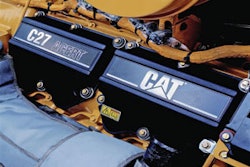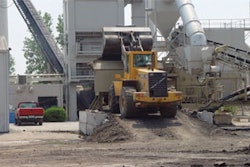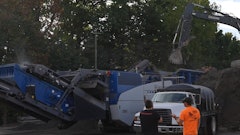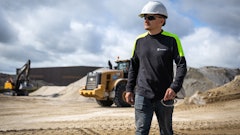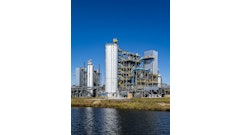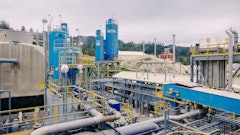
Durable, energy efficient and recyclable--a quick evaluation of concrete applications and it's easy to determine that this versatile building material is sustainable. Just how major a role it will play as the green building movement continues to proliferate depends on how many are willing to take a closer look.
"We want the green building community to realize all of the solutions concrete can provide," said David Shepherd, AIA, and director of sustainable development for the Portland Cement Association.
While Shepherd considers concrete's durability, energy performance and recyclability to be its strongest green attributes, he stresses the importance of the application. "It's how the concrete is used that has the far greatest impact on environmental performance," notes Shepherd.
With proper application, concrete can provide sustainable solutions for a host of green-issues, including: reducing undesirable sound transmission, increased energy performance, urban heat-island reduction, locally available materials sourcing, improving indoor air quality lighting efficiency, storm water management and thermal mass. (Visit for a further explanation of these solutions.)
"It's an extremely durable product," the first and foremost sustainable attribute according to Gary Bailey, AIA, and principal/owner of Innovative Design, Inc. Bailey's firm has been focused on sustainable design since 1977. These days, he favors insulated pre-cast concrete to assist with day lighting and to average out building temperatures due to concrete's thermal mass. "Because of the way heat transfers through concrete, it acts as a storage element, storing warm air in winter and cool air in the summer."
Since concrete does not provide a food source for mold or mildew, Bailey also counts indoor air quality as another component of concrete structures in sustainable design. "Look at health issues in this country, with regards to allergies and asthma--buildings are a big part of that problem. Concrete mitigates those issues."
Echoing the sentiment regarding the versatility is Lionel Lemay, vice president of technical resources for the National Ready-Mixed Concrete Association.
"For instance, look at pervious concrete," says Lemay Beyond its primary benefit of storm water management, he points out that pervious concrete allows for more planting of trees, absorbs noise, potentially decreases the urban heat island effect, and, it can be recycled.
In fact, concrete was the most recycled material in North America by weight in 2005, according to a survey by the Construction Materials Recycling Association (CMRA).
Survey results indicate that recycling companies recovered as much as 140 millions tons of concrete in 2005. Equally impressive, recycling plants were able to recycle 99 percent of what they took in.
A LESSON IN REDUCE, RECYCLE AND REUSE
Just last summer, Recycled Materials Company, Inc., (RMC) of Arvada, Colo., completed the demolition and removal of 6.5 million tons of concrete and asphalt aggregates at the former Stapleton International Airport. With its concrete runways and concourses sprawling throughout the outskirts of Denver, the project was dubbed the "World's Largest Recycling Project." (With the volume of recycled concrete, enough material was recycled to construct a two-lane roadway roughly 1,000 miles in length.)
Soon after the airport closed, construction began on a massive mixed-use development of commercial buildings, energy efficient homes and schools. Developers are conserving resources by using the recycled concrete for the mixed-use development and other construction projects in the Denver metropolitan area.
A study conducted by the Colorado School of Mines found that concrete aggregate produced from the Stapleton recycling project is of equal or higher quality than virgin mixes. Plus, the project virtually eliminates transportation and resulting energy costs.
Also unique to this project, RMC was the first recycling firm to pioneer and implement a "no-cost" reuse and sustainability model. The city of Denver and its citizens didn't pay a penny to RMC for demolition. The firm sells the recycled aggregate to developers and contractors.
ENERGY EFFICIENT AT ANY HEIGHT
In 2003, the nation's first green residential high-rise building, The Solaire, opened with a great deal of publicity and attention in lower Manhattan's Battery Park City Since the landmark opening, neighboring sustainable luxury structures Tribeca Green and The Verdesian have opened and Millennium Tower is currently under construction.
All four structures feature a reinforced concrete structural system, chosen in large part because its thermal mass helps to moderate daily temperature swings, reducing energy and costs needed for heating and cooling.
With this strategically green design, the energy efficiency and savings can be impressive. "The thermal mass properties of a concrete wall are superior to other building materials--no matter the project--building, home, school or hospital," says Ed Alsamsam, PhD, SE, PE, and general manager of PCA's Building Group.
"A concrete building will cut down on lifecycle cost, offering more savings for a building owner in terms of energy efficiency as well as the pocketbook," Alsamsam said.
Ryan M. Puckett has worked in communications during the past 10 years in several capacities, including freelance writer, media liaison and copywriter. His diverse industry experience ranges from sustainable construction to organic agriculture, commercial airplanes and local government.
David Shepherd of the Portland Cement Association points out that both the U.S. Green Building Council and the Green Building Initiative are examining how to incorporate lifecycle analysis (LCA) into their standards (LEED and Green Globes, respectively). With a good tool to measure LCA, Shepherd suspects that concrete will shine. He explains that building a structure and harvesting the materials accounts for about 2 percent of the energy; the other 98 percent is used over the lifetime of the building.
Copyright 2005 LexisNexis, a division of Reed Elsevier Inc. All rights reserved.
Terms and Conditions | Privacy Policy
News stories provided by third parties are not edited by "Site Publication" staff. For suggestions and comments, please click the Contact link at the bottom of this page.





